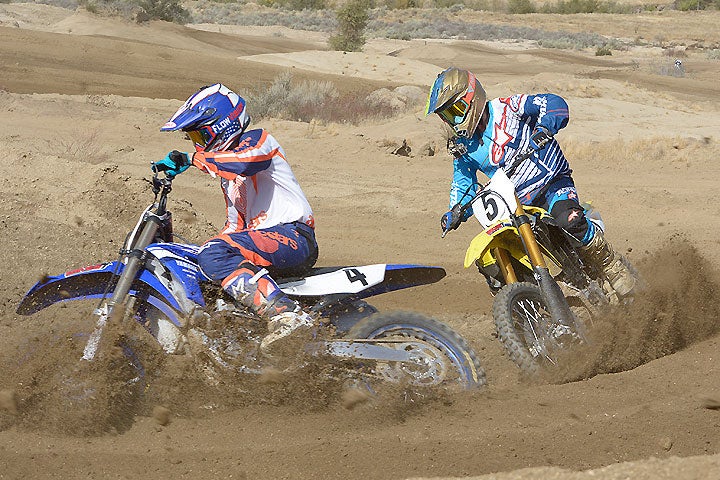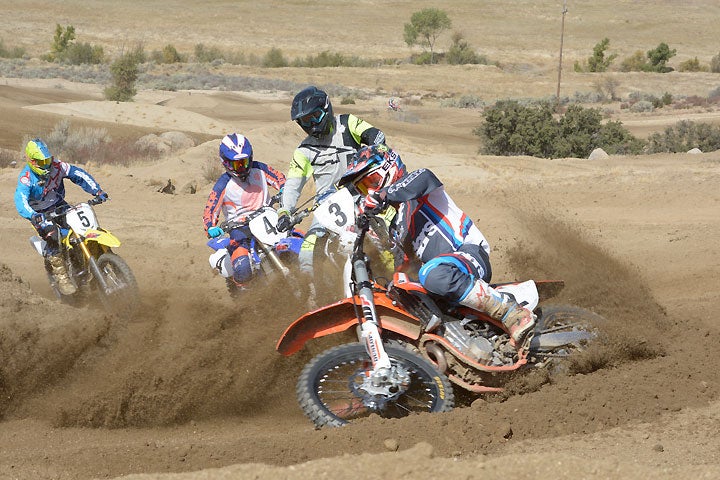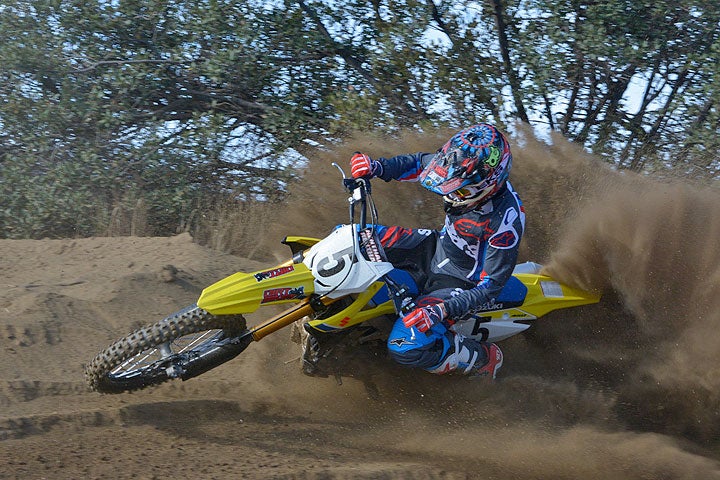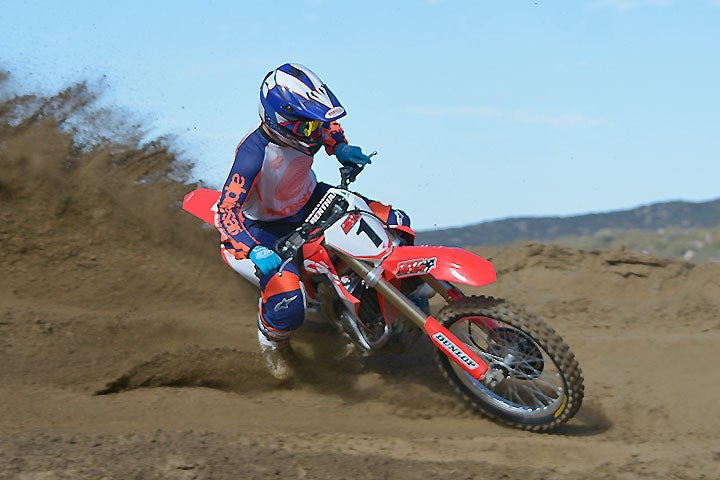Chassis Performance
The Yamaha surprised us by taking top honors in the handling category as well. Its bilateral beam aluminum chassis retains a lot of the character of the 2017 chassis despite featuring straighter and flatter spars in the air box area to give it a slimmer profile, and its tension pipes are much longer than on the 2017 model to help the chassis flex better than the 2017.

Our biggest complaint with the 2017 was that it tended to want to stand up in ruts and tight corners. The new chassis goes a long way toward fixing that by issue, as the steering pipe has been moved 6mm forward while the triple clamp offset is increased from 22mm to 25mm and trail is increased 3mm to 121mm. The Yamaha’s 58.5-inch wheelbase is one of the Still, the Yamaha is one of the heaviest bikes in the class, checking in at 248 lbs. with its 1.6-gallon fuel tank topped. It places 119.5 lbs. on its front wheel and 128.5 lbs. on its rear wheel for a 42%/58% front/rear weight bias.
But the weight didn’t seem to hurt the YZ450F on the track. The classic Yamaha stability is still a main trait of the new chassis, but the 2018 YZ450F also carves corners a lot better than the 2017 did, and that put it over the top in our scoring.
“I was really surprised at how good the Yamaha felt,” Abbatoye said. “To me it’s the most stable bike out there. Some people said that it still likes to push wide, but I feel like it is a lot better in the corners than the 2017 model. It corners really well. It doesn’t oversteer, and it doesn’t push to the outside.”
Stover was even more glowing in his assessment.
“I think they fixed it,” he said of the Yamaha’s newfound cornering capability. “It really wants to dive into corners. Last year there was the issue of it not wanting to stay hunkered down. It’s like they took a play out of the Suzuki’s playbook for turning. At high speed it is a little more finicky than some of the other bikes in the class, but I wouldn’t say it’s unstable.”
The lightest bike in the class, the KTM 450 SX-F spreads its feathery 234.3 lbs., along a 58.3-inch wheelbase, placing 112.4 lbs. on the front wheel and 121.9 lbs. on the rear wheel. Its WP-designed chassis is made of 25CrMo4 chrome-moly steel–the European spec equivalent of what is known as 4130 chrome-moly in the USA, making the KTM and the Husqvarna the remaining holdouts using steel frame construction in the 450cc motocross class. Conventional chassis wisdom is that steel chassis still offer better feel and better bump absorption than aluminum, a notion to which Abbatoye subscribes.
“The KTM feels pretty good,” he said. “It has that steel frame, so it has a more compliant, forgiving feel than any of the aluminum chassis. I like that feel. It turns really well, inside or outside, and it’s really stable. It sticks really well, and it tracks really well.”

Stover noted that the KTM 450 SX-F chassis feels “the same as the Husky. It feels really good. You just don’t get any harsh feedback from the chop. The frame does such a good job of absorbing everything without transferring it to the rider. It turns really well. It’s right near the top of the class. It likes tighter corners better than sweepers, but it works well at both.”
You’d think that if the KTM felt that good, then it follows that the Husqvarna would as well, and yet the battle for third in our Chassis Performance category came down to the Suzuki RM-Z450 and the Honda CRF450R, with the Suzuki just edging the Honda in the opinion of our crew. Suzuki engineers clearly put a lot into improving the RM-Z’s twin-spar aluminum frame, making it slimmer and shaving 1.32 lbs. weight from the package. Even so, the Suzuki checks in at 250.3 lbs. the heaviest bike in the class—and that’s without an electric starting system, which would add even more weight. But, funny thing, Suzuki has its steering geometry so dialed-in that you’d never know the RM-Z weighs as much as it does on the track. When it comes to cornering, the RM-Z450 has been hard to beat for the past few years, and that much remains unchanged. Even better, the new chassis is more stable than past versions.
“The Suzuki’s straight-line stability is actually surprising,” Smith said. “You can feel how well it turns, but when you’re going through acceleration bumps on the track, it tracks straight. You can dive it into a corner quickly as well. It can change direction really quickly when you want it to. It is very confidence-inspiring.”
Stover added that the Suzuki ranks well in the handling department because it’s very precise.
“It wants to go where you want it to go,” Stover said. “It doesn’t oversteer or understeer. You can hit the same lines over and over again. And it’s a Suzuki, so it corners like a dream, but in a straight line it’s very stable. I didn’t hit anything that made it go sideways or headshake. No complaints at all.”

However, Abbatoye noted that while it corners great, the Suzuki chassis still imparts a stiff ride compared to some of the other bikes in the class.
“It’s better,” he said. “But it still has a rigid feel.”
So, how is that the Honda slid so far backward despite not being changed by a single degree or millimeter? Remember that suspension tweak Honda made to give the Honda a bit more resistance in the bumps? Suspension performance is a vital piece of the puzzle when it comes to handling.
“It turns really well, and Honda’s have never had an issue with that, but in a couple corners it tended to oversteer,” Abbatoye said. “I think that had to do with it having a rear spring that was too stiff. It doesn’t shake or do anything weird, though.”
Smith was also critical of the Honda’s handling.
“Stink bug feel,” he said. “The front end of the chassis is really rigid, too, and it was giving me too much feedback. I think the frame could stand to flex a little more. It’s either that or maybe the triple clamps.”

Stover was less critical of the CRF’s handling.
“The Honda has very good handling,” Stover said. “It likes going inside or railing corners, and it feels really light in the air. When you’re on the gas or braking, it’s good. If you’re on the gas and chop the throttle, it tends to unload and get light on the front end.”
The Kawasaki KX450F rated the lowest in the category. It isn’t the KX handles poorly, and at 240.1 lbs., full of fuel, it isn’t the heaviest bike in the class, but it is the most nervous. The majority of our testers complained that the green machine’s straight-line stability wasn’t as solid as the other bikes in the shootout.
“After riding the other bikes, the KX took some getting used to,” Abbatoye said. “It shook its head for me. It doesn’t corner badly, but it likes outside corners rather than inside corners. Other bikes turn tighter. Straight line stability isn’t very good.”
Stover noted that the Kawasaki can handle tight corners if the rider steers it with the throttle.
“It will follow the front in real tight corners if you are hard on the brakes, but once you get back on the throttle, you really have to get on it to get Kawasaki to finish a tight line,” Stover said. “It feels a little heavy in the air, but it is really predictable. It has a slightly heavier feeling than the other bikes.”
Smith agreed, noting that the Kawi’s steering effort is heavier and its steering response is slower than the rest of the class.
“It still feels like it tracks well through corners, but it just takes more steering effort to get it to switch lines,” he said.
2018 450cc Motocross Shootout Chassis Performance Results
1. Yamaha YZ450F
2. KTM 450 SX-F
3. Suzuki RM-Z450
4. Honda CRF450R
5. Husqvarna FC 450
6. Kawasaki KX450F
 Your Privacy Choices
Your Privacy Choices